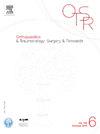In proximal tibial anterior closing wedge (slope changing) osteotomy lower starting points imply larger bone resection
IF 2.2
3区 医学
Q2 ORTHOPEDICS
引用次数: 0
Abstract
Background
Anterior closing wedge osteotomy (ACWO) for tibial slope correction is a validated procedure in revision anterior cruciate ligament reconstruction (ACLR). This study aims to determine how different starting points of the osteotomy affect the amount of bone resection in ACWO.
Hypothesis
We hypothesized that the lower osteotomy starting points in ACWO imply larger bone resection.
Patients and methods
A total 52 patients who underwent ACWO using infra-tuberosity technique in our institution were included in this study. Each of patients was simulated using additional two separate methods (based on osteotomy level: supra- and trans-tuberosity) based on lateral calibrated pre-operative X-rays of the whole tibia according to the post-operative correction angle. The resection height of the closing wedge, which corresponded to the base of the osteotomy, was measured and compared among the three groups.
Results
The mean actual pre-operative proximal posterior tibial angle (PPTA) was 75.8 ± 2.0°. Post-operatively, PPTA was 84.0 ± 0.6°, and correction angle was 8.2 ± 2.2°. The mean resection height in the supra-tuberosity group was 7.5 ± 0.2 mm, 8.0 ± 2.1 mm in the trans-tuberosity group, and 9.2 ± 2.1 mm in the infra-tuberosity group. There were significant differences between each approach (p ≦ 0.0001). Resection height was moderate positively correlated with the starting point of osteotomy (r = 0.33, 95%CI: 0.18–0.46, p < 0.0001).
Conclusion
This study suggests that selecting a distal starting point for the osteotomy in ACWO is directly proportional to the observed increase in bone resection, providing valuable insights for pre-operative planning. These findings are clinically relevant and will aid in preoperatively deciding approach in ACWO.
Level of evidence
IV; retrospective case-control study.
在胫骨近端前方闭合楔形(斜坡改变)截骨术中,较低的起点意味着较大的骨切除。
背景:用于矫正胫骨斜度的前闭合楔形截骨术(ACWO)是前交叉韧带重建术(ACLR)中的一种有效手术。本研究旨在确定不同的截骨起点如何影响 ACWO 的骨切除量:我们假设 ACWO 中较低的截骨起点意味着较大的骨切除量:本研究共纳入了 52 例在我院使用瘤下技术进行 ACWO 的患者。每位患者都根据术后矫正角度,在术前整个胫骨的侧位校准 X 光片基础上,使用另外两种不同的方法(基于截骨水平:瘤上和瘤下)进行模拟。测量闭合楔的切除高度(相当于截骨底部),并在三组之间进行比较:结果:术前胫骨近端后角(PPTA)的实际平均值为 75.8 ± 2.0°。术后,PPTA 为 84.0 ± 0.6°,矫正角度为 8.2 ± 2.2°。乳突上组的平均切除高度为(7.5 ± 0.2)毫米,经乳突组为(8.0 ± 2.1)毫米,乳突下组为(9.2 ± 2.1)毫米。每种方法之间均有明显差异(p ≦ 0.0001)。截骨高度与截骨起点呈中度正相关(r = 0.33,95%CI:0.18-0.46,p 结论:截骨高度与截骨起点呈中度正相关(r = 0.33,95%CI:0.18-0.46,p):本研究表明,在 ACWO 中选择远端截骨起点与观察到的骨切除增加成正比,为术前规划提供了宝贵的见解。这些发现与临床相关,有助于术前决定 ACWO 的方法:证据级别:IV;回顾性病例对照研究。
本文章由计算机程序翻译,如有差异,请以英文原文为准。
求助全文
约1分钟内获得全文
求助全文
来源期刊
CiteScore
5.10
自引率
26.10%
发文量
329
审稿时长
12.5 weeks
期刊介绍:
Orthopaedics & Traumatology: Surgery & Research (OTSR) publishes original scientific work in English related to all domains of orthopaedics. Original articles, Reviews, Technical notes and Concise follow-up of a former OTSR study are published in English in electronic form only and indexed in the main international databases.

 求助内容:
求助内容: 应助结果提醒方式:
应助结果提醒方式:


